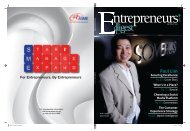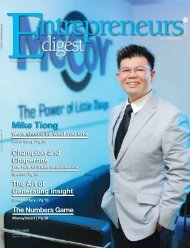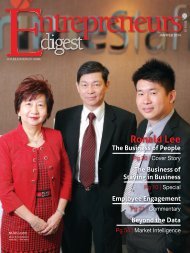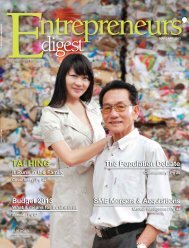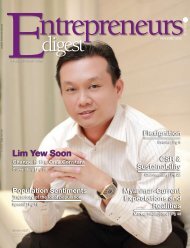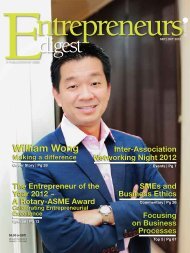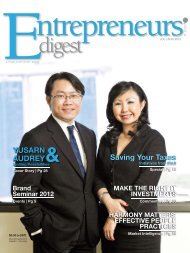ED 49: May-June 2013
You also want an ePaper? Increase the reach of your titles
YUMPU automatically turns print PDFs into web optimized ePapers that Google loves.
44<br />
Ma r k E t in t E l l i gE n C E<br />
coulD your buSineSS<br />
be an IP goldmIne?<br />
Leveraging on intellectual property<br />
Property” is<br />
the current buzzword<br />
circulating in the business<br />
community or appearing<br />
“intellectual<br />
in news articles in the<br />
local media. “Intellectual Property” - that<br />
sounds pretty abstract. What exactly is<br />
it?<br />
“Intellectual Property” or “IP” in short is<br />
about protecting your brand, ideas and/<br />
or innovation and this is accomplished<br />
via protective rights like Patents,<br />
Trademarks and Designs.<br />
If you are a business owner, it is a good<br />
idea to make IP part of your business<br />
strategy. It could help you protect your<br />
key intellectual assets, stop your direct<br />
competition from using them and bring<br />
you revenue through commercialisation<br />
and even strategic alliances where e.g.<br />
you provide the technical know-how<br />
and your strategic partner provides the<br />
funding. Significant global corporations<br />
and even homegrown companies have<br />
invested in their IP. They capitalise on<br />
protective rights first to ensure returns<br />
on investment put into research and<br />
development (R&D) and second to help<br />
turn their ideas and innovations into<br />
profits, and create brand value.<br />
Depending on the nature of your IP<br />
assets, it can be protected by e.g.<br />
patents, designs or trademarks, or<br />
sometimes even by more than one of<br />
these protective rights. The following<br />
is an overview of the two primary<br />
categories of protective rights: Patent<br />
and Trademarks.<br />
patents<br />
This is a form of protective right that<br />
is used to protect your inventions, the<br />
technical realisation of your ideas. A<br />
Patent is an exclusive right conferred by<br />
a government for a maximum period of<br />
20 years. It gives you, the patent owner,<br />
<strong>May</strong> | Ju n <strong>2013</strong><br />
En t r E p r E n E u r s’ Di g E s t<br />
the legal right to exclude anyone else<br />
from manufacturing, using or selling your<br />
patent product or method. During this<br />
period of exclusivity, you can monetize<br />
your key assets through licensing or<br />
collecting royalties whilst at the same<br />
time, bar your competitors from copying<br />
your ideas and diluting your market<br />
share.<br />
It is fundamentally important that your<br />
ideas are kept fully confidential and not<br />
divulged to anyone before you apply for<br />
a Patent with the patents registry, as<br />
Patents are granted only for something<br />
new, meaning that it is not (yet) known<br />
by others, the public. In order to ensure<br />
that your idea is legally protected, a<br />
patent application should be filed as<br />
soon as possible since protection and<br />
eventual grant is based on a “first-tofile<br />
system”. To this extent, for example,<br />
a local (Singapore) patent application<br />
could first be filed. Further applications<br />
in other industrial countries of interest<br />
may then be filed within one year of<br />
the local (Singapore) filing and these<br />
further applications will then be treated,<br />
regarding patentability, as if they would<br />
have been filed on the date of the first<br />
filing (i.e. the Singapore application).<br />
trademarks<br />
When a customer has had good<br />
experience with your product or<br />
service, you want them to repeat that<br />
experience or tell others about it, and<br />
it is your trademark that will facilitate<br />
this. Valuable goodwill resides in<br />
your trademark and it is critical that<br />
you proactively protect it, by securing<br />
registrations and enforcing them.<br />
Many companies have numerous<br />
trademarks but all businesses would<br />
have at least one trademark which may<br />
be the same as the business name.<br />
Toyota Corporation uses their TOYOTA<br />
house mark as well as many sub-marks<br />
like ALTIS, VIOS, CAMRY, PICNIC, etc.<br />
A trademark can be a symbol like Apple<br />
Corporation’s titular apple or a slogan<br />
like Nike’s “JUST DO IT”. Colours like<br />
the green and yellow that identifies BP<br />
petrol stations, a jingle like the short tune<br />
that Hisamitsu used, or shape of the<br />
product or packaging like the Toblerone<br />
chocolate or the Nescafe bottle can be<br />
considered trademarks as well.<br />
A list of all the possible trademarks of<br />
your company should be made and then<br />
ask yourself the following questions:<br />
a. Have we secured trademark<br />
registrations for all of them?<br />
b. Do the registrations cover all the<br />
goods and services we offer or are<br />
likely to offer in the near future?<br />
c. Do we have adequate trademark<br />
registrations in all the countries<br />
where we trade or where our goods<br />
or services may be distributed?<br />
d. Are our trademarks being used<br />
by our staff, advertising and<br />
marketing personnel or agents,<br />
distributors or licensees correctly?<br />
For example, marks should always<br />
be accompanied by the correct<br />
marking (® where registered or <br />
if not yet), and should not be used<br />
in ways that may lead to the mark<br />
becoming the name of the product/<br />
service - OTIS lost exclusive rights<br />
to the use of “ESCALATOR”<br />
because of this. E<br />
adam bogsch<br />
viering, Jentschura & partner llp<br />
M ravindran & angela leong<br />
ravindran associates




